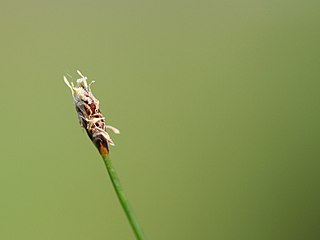
The Cyperaceae are a family of graminoid (grass-like), monocotyledonous flowering plants known as sedges. The family is large, with some 5,500 known species described in about 90 genera, the largest being the "true sedges" genus Carex with over 2,000 species.

Windsor Hill Marsh is a 0.84 hectare biological Site of Special Scientific Interest, north of the town of Shepton Mallet in Somerset, and adjacent to the Windsor Hill Quarry geological Site of Special Scientific Interest. It was notified in January 1972.

Eleocharis is a virtually cosmopolitan genus of 250 or more species of flowering plants in the sedge family, Cyperaceae. The name is derived from the Greek words ἕλειος (heleios), meaning "marsh dweller," and χάρις (charis), meaning "grace." Members of the genus are known commonly as spikerushes or spikesedges. The genus has a geographically cosmopolitan distribution, with centers of diversity in the Amazon Rainforest and adjacent eastern slopes of the South American Andes, northern Australia, eastern North America, California, Southern Africa, and subtropical Asia. The vast majority of Eleocharis species grow in aquatic or mesic habitats from sea level to higher than 5,000 meters in elevation.

Eleocharis acicularis is a species of spikesedge known by the common names needle spikerush and least spikerush. It is widespread across Europe, central and southeastern Asia, North America and northeastern South America as far south as Ecuador. It is also found in Australia, where it is probably an introduced species.
Eleocharis vivipara is a species of flowering plant in the sedge family known by several common names, including umbrella hairgrass, sprouting spikerush, and viviparous spikerush. It is native to the southern United States from eastern Texas to eastern Virginia. It takes the form of a clump of thin stems. A spike of flowers appears at the tip of the stem. The plant may also reproduce by growing a plantlet and runners.
Eleocharis atropurpurea is a species of spikesedge known by the common name purple spikerush. This is an aquatic plant native to much of. It also has a wide distribution in temperate regions of North and South America and Asia. It is present in Europe, where it may be an introduced species for the most part.
Eleocharis geniculata is a species of spikesedge known by several common names, including bent spikerush and Canada spikesedge. This is a widespread plant of wet areas in the Americas, Asia, Africa, Australia, Madagascar, and some Pacific Islands. It is an annual spikesedge growing to a maximum height of about 40 centimeters. It has a few straw-colored leaves and many thin erect stems. The stems hold inflorescences of rounded spikelets each containing at least 10 tiny flowers. The flowers are covered with dark greenish-brown bracts. The fruit is a shiny purple-brown achene not more than a millimeter long.

Eleocharis macrostachya is a species of spikesedge known by the common name pale spikerush.

Eleocharis quinqueflora is a species of spikesedge known by the common names fewflower spikerush and few-flowered spike-rush. It is widespread across Europe, North Africa, northern Asia, and North America. There are also isolated populations in Argentina and Chile.

Eleocharis palustris, the common spike-rush, creeping spike-rush or marsh spike-rush, is a species of mat-forming perennial flowering plants in the sedge family Cyperaceae. It grows in wetlands in Europe, North Africa, northern and central Asia and North America. Eleocharis palustris is not easily distinguished from other closely related species and is extremely variable worldwide itself. The species epithet palustris is Latin for "of the marsh" and indicates its common habitat.

Eleocharis parvula is a species of spikesedge known by the common names dwarf spikerush, small spikerush and hairgrass in aquaria. It is a plant of brackish and saltwater habitat, such as marshes and mudflats. It is a perennial herb growing tufts of spongy, compressible stems not more than 10 centimeters tall. The plant grows from a tuber which is J-shaped or horseshoe-shaped, a characteristic that helps in the identification of the species. The inflorescence is an oval-shaped spikelet just 2 or 3 millimeters long, made up of several tiny flowers.

Eleocharis rostellata is a species of spikesedge known by the common name beaked spikerush. It is widespread across North America, with isolated populations in Argentina.
Eleocharis halophila, the saltmarsh spikerush, is a perennial halophytic plant endemic to salt marshes in eastern Canada, in Ontario in Hudson Bay and James Bay, Quebec in the St. Lawrence Seaway as far as the city of Quebec, Newfoundland and Nova Scotia and in the United States from Maine to North Carolina. It is one of 76 species of Eleocharis amongst the 36 genera in the sedge family (Cyperaceae).

Eleocharis torticulmis is a rare species of flowering plant in the sedge family known by the common names twisted spikerush and twist-stem spikerush. It is endemic to Plumas County, California, where it is known from two locations within a kilometer of each other in the Butterfly Valley Botanical Area. It grows in open wet habitat such as fens and meadows. It was separated from Eleocharis suksdorfiana and described to science as a new species in 2001.

Trichophorum cespitosum, commonly known as deergrass or tufted bulrush, is a species of flowering plant in the sedge family. It was originally described by the Swedish naturalist Carl Linnaeus in 1753 as Scirpus cespitosus, but was transferred to the genus Trichophorum by the Swedish botanist Carl Johan Hartman in 1849, becoming Trichophorum cespitosum.

Eleocharis ochrostachys, commonly known as spike rush, is a sedge of the family Cyperaceae that is native to Australia and Asia.

Eleocharis microcarpa, common names small-fruited spikesedge, spike-rush, small-fruited spike-rush and tiny-fruited spike-sedge, is a plant in the Eleocharis genus found in North America.

Eleocharis flavescens is a perennial flowering plant species called bright green spikerush, pale spike-rush, or wrinkle-sheathed spike-rush; it is a type of spikerushes belonging to Juncaceae. It is clump-forming species that also spreads into colonies. It is a small species that looks similar to other Spikerush species. It is native to temperate North America, the West Indies, and South America.














